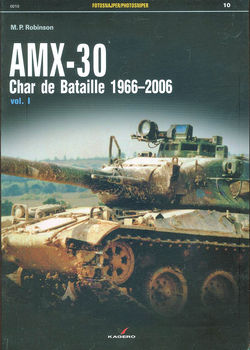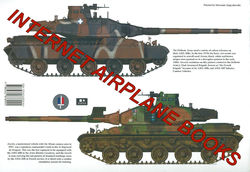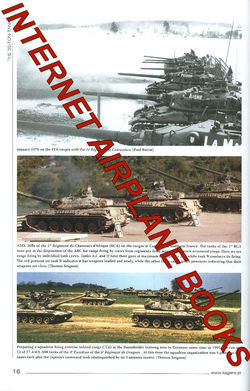KAGERO AMX-30B 30-TON MAIN BATTLE TANK MBT FRENCH ARMY CHAR de BATAILLE 1966-2006 EUROPA PANZER (PART 1)
***IN
ENGLISH***
KAGERO
PHOTOSNIPER SERIES No.10 SOFTBOUND BOOK BY M.P. ROBINSON (80 PAGES)
SUPER
DETAILED WITH BOTH B&W AND COLOR CLOSE-UP PHOTOGRAPHS.
PAGES
OF COLOR PROFILES
---------------------------------------------------------------------------------------------------------------
Additional
Information from Internet Encyclopedia
The
AMX-30 is a main battle tank designed by Ateliers de construction
d'Issy-les-Moulineaux (AMX, then GIAT) and first delivered to the French Army
in 1966. The first five tanks were issued to the 501st R�giment de Chars de
Combat (Tank Regiment) in August of that year. The production version of the AMX-30
weighed 36 metric tons (40 short tons), and sacrificed protection for increased
mobility. The French believed that it would have required too much armour to
protect against the latest anti-tank threats, thereby reducing the tank's
maneuverability. Protection, instead, was provided by the speed and the compact
dimensions of the vehicle, including a height of 2.28 metres. It had a 105 mm
gun, firing a then advanced high explosive anti-tank warhead known as the Obus
G. The Obus G used an outer shell, separated from the main charge by ball
bearings, to allow the round to be spin stabilized by the gun without affecting
the warhead inside. Mobility was provided by the 720 horsepower (540 kW) HS-110
diesel engine, although the troublesome transmission adversely affected the
tank's performance.
It
was preceded by two post-war French medium tank designs. The first, the ARL 44,
was an interim tank. Its replacement, the AMX 50, was cancelled in the
mid-1950s in favor of adopting the M47 Patton tank. In 1956, the French
government entered a cooperative development program with Germany and Italy in
an effort to design a standardized tank. Although the three nations agreed to a
series of specific characteristics that the new tank should have, and both
France and Germany began work on distinctive prototypes with the intention of
testing them and combining the best of both, the program failed as Germany
decided not to adopt the new French 105-millimetre (4.1 in) tank gun and France
declared that it would postpone production until 1965. As a result, both
nations decided to adopt tanks based on their own prototypes. The German tank
became known as the Leopard 1, while the French prototype became the AMX-30.
As
early as 1969, the AMX-30 and variants were ordered by Greece, soon followed by
Spain. In the coming years, the AMX-30 would be exported to Saudi Arabia,
Venezuela, Qatar, the United Arab Emirates, Cyprus and Chile. By the end of
production, 3,571 units of AMX-30s and its variants had been manufactured. Both
Spain and Venezuela later began extensive modernization programs to extend the
life of their vehicles and to bring their tanks up to more modern standards. In
the 1991 Gulf War, AMX-30s were deployed by both the French and Qatari armies.
Qatari AMX-30s saw action against Iraqi forces at the Battle of Khafji. France
and most other nations replaced their AMX-30s with more up-to-dateequipment by
the end of the 20th century.
De
Gaulle decided that France, though formally remaining a member, would no longer
participate in the NATO military organization. This caused a rift between
France and West Germany, which then started to emphasize standardization with
American equipment, especially in armament, and to follow the new NATO policy
to use multifuel diesel engines.[23] German defence minister Franz Josef
Strauss began to oppose the common tank project.[23] In July 1963, the defence
committee of the German Bundesrat decided to procure a purely national
tank.[28] In response, the same month the French government decided likewise.
Comparative
trials were nevertheless held at Mailly-le-Camp, Meppen, Bourges and Satory[17]
between five French and five German prototypes between August and October 1963,
under Italian, Dutch, Belgian and American supervision. The French type
had received a separate national designation: AMX 30.[28] The trials indicated
that the German type, on 1 October also getting its own name Leopard, had a
better mobility and acceleration. The French government decided that it
could not procure a new tank until 1965, while the Germans refused to adopt
the Franco-German 105-millimeter (4.1 in) tank gun, in lieu of the British
Royal Ordnance L7, of which they had already ordered 1,500 in the autumn of
1962, their plan having failed for Rheinmetall to produce in Germany a
common type of munition of sufficient quality.[23] Suggestions to save the
project by combining the French turret with the German chassis failed.[23] As a
result, the program was cancelled and the French and Germans definitely decided
to adopt their two separate tanks.
The
prototypes of the AMX-30 weighed 32.5 metric tons (35.8 short tons), and were
compact, with a width of 3.1 metres (10 ft), comparable only to the Swiss
Panzer 61, and a height of 2.28 meters (7.5 ft), comparable only to the Soviet
T-55. In contrast to the AMX 50, the AMX-30 was issued a conventional turret,
because it was found that it was more difficult to seal oscillating turrets
from radioactive dust and against water when the tank was submerged.[24]
Oscillating turrets also had a large ballistic weakness in the area of the
skirt and turret ring.[33] Originally, the first two prototypes were powered by
a 720 horsepower (540 kW) spark ignition engine, named the SOFAM 12 GSds. Later,
a multi-fuel diesel engine was adopted, developed by Hispano-Suiza. The seven
1963 prototypes of the AMX-30 were later rebuilt with the new diesel
engine.[34] Two further prototypes, meant to be direct preproduction vehicles,
were delivered in November 1965. Besides the diesel engines, they had changed
hull and turret casts and different gun mantlets; the latter would again be
changed in the production vehicles.
The
first production versions of the AMX-30, named AMX 30B to distinguish them from
the AMX 30A prototypes,[36] were completed in June 1966, manufactured with a
welded and cast hull and a fully cast turret.[12] The production version of the
tank had a combat weight of 36 metric tons (40 short tons).[37] The AMX-30's
survivability was based on its mobility; French engineers believed that the
tank's mobility would have been compromised had they added enough steel plating
to protect against modern anti-tank threats, including high explosive anti-tank
warheads (HEAT). As a result, the type had the thinnest armour of any main
battle tank produced at the time.[38] The turret has a maximum armour thickness
of 50 millimetres (2.0 in), the armour sloped at 70 degrees on the front plate
and 23 degrees on the side, offering protection against 20-millimetre (0.79 in)
armour piercing projectiles.[39] The Line-of-Sight armour values are:
79-millimeter (3.1 in) for the front of the hull; 59-millimetre (2.3 in) for
the forward sides of the hull; 30-millimetre (1.2 in) for the rear sides and
rear of the hull; 15-millimetre (0.59 in) for the hull top and bottom;
80.8-millimeter (3.18 in) for the turret front; 41.5-millimeter (1.63 in) for
the turret sides; 50-millimetre (2.0 in) for the turret rear and 20-millimetre
(0.79 in) for the turret top.[40] Further protection is offered by a nuclear,
biological and chemical protection suit, including a ventilation system.
One
of the unique features of the AMX-30 was the Obus � Charge Creuse de 105 mm
Mod�le F1 (Obus G) HEAT projectile and its main gun,[37] the Mod�le F1, a monoblock
steel 105-millimeter (4.1 in) cannon.[42][43] HEAT warheads suffer when spin
stabilized, a product of rifled barrels,[44] causing the French to develop the
Obus G,[34] (Gresse).[15] This projectile was composed of two major parts,
including the outer shell and a suspended inner shell, divided by ball
bearings. This allowed the projectile to be spin-stabilized, and therefore more
accurate than a normal fin-stabilized HEAT-round, while the inner shell did not
move, allowing the warhead to work at maximum efficiency. The warhead,
containing 780 gram hexolite,[45] could penetrate up to 400 millimeters (16 in)
of steel armour and was effective against tanks at up to 3,000 meters (3,300
yd). As it combined a good accuracy with a penetration that was independent of
range, it has been considered an "ideal round" for its day[34] The
AMX-30 was also designed to fire the OCC F1 Mle.60 high explosive projectile,
the SCC F1 training warhead and the OFUM PH-105 F1 smoke round.[46] The main
gun was coupled with a 380-millimeter (15 in) recoil brake, which had a maximum
extension of 400 millimeters (16 in), and could depress to −8 degrees or
elevate to 20 degrees. The turret's firepower was augmented by a coaxial
12.7-millimeter (0.50 in) M2 Browning machine gun. The tank commander also made
use of a 7.62-millimeter (0.300 in) anti-aircraft machine gun on the turret
roof.[47] The vehicle carried 50 105-millimeter (4.1 in) projectiles,[47] 748
12.7-millimeter (0.50 in) rounds and 2,050 7.62-millimeter (0.300 in) bullets.[48]
The tank commander was issued a cupola which offered ten all-around
direct-vision episcopes, and a binocular telescope with 10x magnification. The
commander was also given an optical full-field coincidence range finder. The
gunner was given a telescoping gun sight and two observation periscopes.
The
production version of the AMX-30 was fitted with Hispano-Suiza's HS-110 diesel
engine, located in the rear of the hull. The 28.8 liters (1,760 cu in) engine
could be replaced on the field in 45 minutes, and produced 720 horsepower (540
kW), offering the tank a maximum velocity of 65 kilometers per hour (40 mph) on
roads. The fuel efficient engine, in conjunction with a total fuel capacity of
970 liters (260 U.S. gal), gave the AMX-30 a maximum road range of up to 600
kilometers (370 mi).[49] The engine's drive is taken through a Gravina
G.H.B.200C twin-plate centrifugal clutch.[50] The gearbox was an AMX 5-SD-200D,
with five forward gears and five reverse gears. This transmission was heavily
influenced by that of the German Panther tank and was based on a project which
had begun in 1938. The transmission was one of the AMX-30's major faults and
caused a variety of mechanical problems, including that the driver would have
to manually change gears at specific times, even if the tank was moving over
rough terrain.[51] The tank's weight is distributed over five double,
aluminum-alloy, rubber-tyred road wheels on either side, propelled on
570-millimeter (22 in) wide tracks.[52] The tank could ford 1.3-meter (1.4 yd)
deep water obstacles without preparation, up to 2 meters (2.2 yd) with minor
preparation, and up to 4 meters (4.4 yd) with full preparation.[38] Full
preparation for water operations consisted of the addition of a snorkel tube,
the installation of blanking plates, carried on the front of the hull, over the
engine compartment's air intake louvers,[53] and the installment of infra-red
driving equipment, including a searchlight.[12] In 1969 a single special dive
training vehicle was adapted, nicknamed the AMX 30 Gloutte (from French faire
glouglou, "gurgle"), without engine and tracks, that over a ramp
could quickly be lowered into a reservoir by a winch; it was equipped with an
escape tube.
Qatari
AMX-30s saw combat during the Gulf War at the Battle of Khafji, where on 30
January 1991 they counter-attacked in an attempt to retake the city of Khafji
from Iraqi forces which had occupied it the night before. During the action,
Qatari AMX-30s knocked out three Iraqi T-55s and captured four more.[132] At
least one Qatari AMX-30 was lost during the battle.
The
French participation in the Gulf War, codenamed Op�ration Daguet, saw the
deployment of the 6e Division L�g�re Blind�e ("6th Light Armoured
Division"),referred to for the duration of the conflict as the
Division Daguet. Most of its armoured component was provided by the AMX-10RCs
of the cavalry reconnaissance regiments, but a heavy armoured unit, the 4e
R�giment de Dragons ("4th Dragoon Regiment") was also sent to the region
with a complement of 44 AMX-30B2s.[135] Experimentally, a new regimental
organisational structure was used, with three squadrons of thirteen tanks, a
command tank and six reserve vehicles, instead of the then normal strength of
52 units.[136] Also six older AMX-30Bs were deployed, fitted with Soviet mine
rollers provided by Germany from East German stocks, and named AMX 30
Demin.[136] The vehicles were all manned by professional crews, without
conscripts.[136] The Daguet Division was positioned to the West of the Coalition
forces, to protect the left flank of the U.S. XVIII Airborne Corps. This
disposition gave the French commander greater autonomy, and also lessened the
likelihood of encountering Iraqi T-72s, which were superior both to the
AMX-10RCs and the AMX-30B2s.[137] With the beginning of the ground offensive of
24 February 1991, French forces moved to attack its first target,
"Objective Rochambeau", which was defended by a brigade from the
Iraqi 45th Infantry Division. A raid by Gazelle helicopters paved the way for
an attack by the 4e R�giment de Dragons. Demoralized by heavy coalition
bombardments, the Iraqi defenders rapidly surrendered.[138] The following day,
the 4e Dragons moved on to their next objective, "Chambord", where
they reported destroying ten tanks, three BMPs, fifteen trucks and five mortars
with the assistance of USAF A-10s, and capturing numerous prisoners. The final
objective was the As-Salman air base ("Objective White"), that was
reported captured by 18:15, after a multi-pronged attack, with the 4e Dragons
attacking from the south.[139] In all, the AMX-30s fired 270 main gun rounds.








